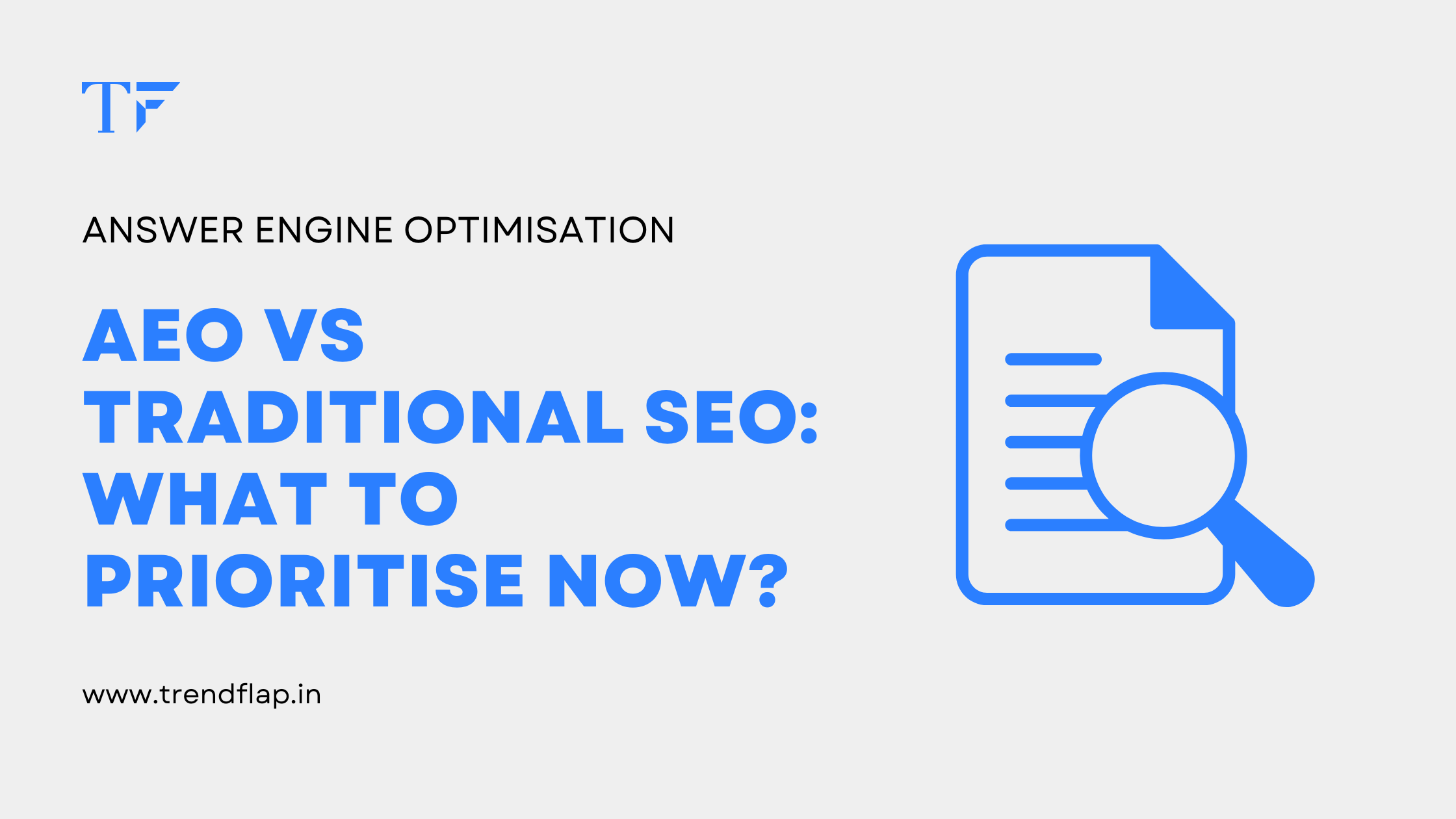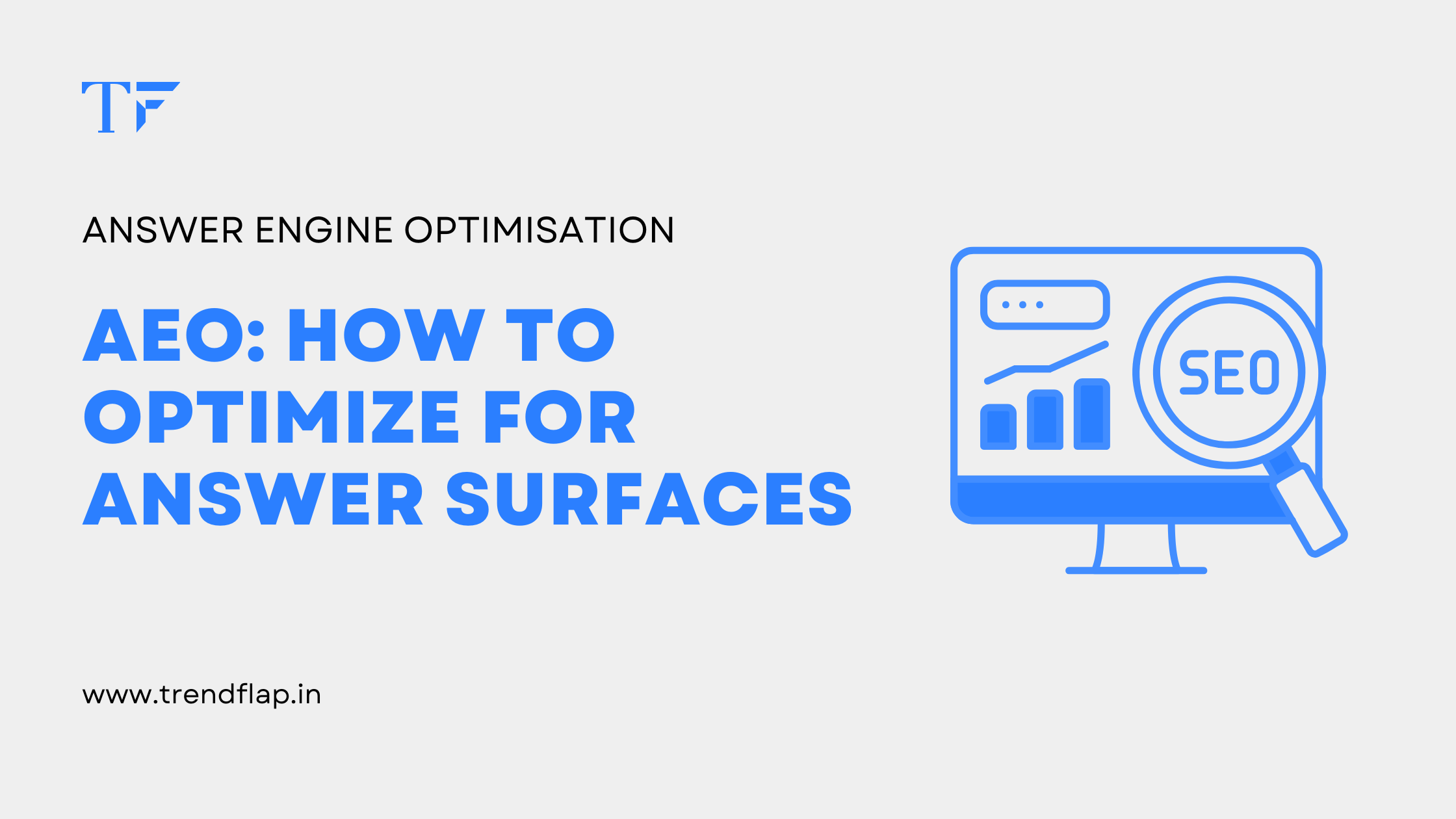
AEO vs Traditional SEO: What to Prioritise Now
Discover the key differences between AEO and SEO. Learn what to prioritize in 2026 with stats, expert insights, and tips for AI search visibility.
Loading...
Master AEO (Answer Engine Optimization) including voice search optimization, featured snippets, AI Overviews, zero-click strategies, and conversational keywords to dominate answer engines in 2025.
AEO (Answer Engine Optimization) is the practice of optimizing content to appear in AI-powered search results, voice assistants, and answer engines like ChatGPT, Google AI Overviews, and Perplexity. Unlike traditional SEO that focuses on ranking web pages, AEO optimizes for direct answers and citations in AI-generated responses.
The shift is dramatic: 60% of Google searches in 2025 result in zero-clicks, meaning users get answers without visiting websites. With 8.4 billion voice assistants in use globally and 65% of searches ending in zero-click results, optimizing for answer engines is no longer optional—it's essential for maintaining digital visibility.
"AEO helps content appear as direct answers in search results. It focuses on answering user questions quickly and clearly by understanding search intent and providing well-structured content." - Research from AI Multiple
From my experience implementing AEO strategies, I've observed that businesses focusing on structured, conversational content see significant improvements in voice search visibility and featured snippet captures. The key is creating content that AI models can easily understand, extract, and present as authoritative answers.
While traditional SEO targets keyword rankings and click-through traffic, AEO optimizes for being cited and referenced in AI-generated responses. The fundamental shift moves from optimizing for search engines to optimizing for answer engines.
| Aspect | Traditional SEO | AEO |
|---|---|---|
| Primary Goal | Rank high in SERPs | Get cited in AI responses |
| Content Focus | Keyword optimization | Direct answers, conversational language |
| Success Metrics | Rankings, traffic, CTR | Citations, voice mentions, featured snippets |
| Content Structure | Keyword density, headings | Schema markup, FAQ format, natural language |
The evolution requires a mindset shift from competing for clicks to competing for authority and trust. AEO success means your content becomes the source that AI engines reference when answering user questions, establishing your brand as the go-to authority in your field.
Voice search optimization requires understanding how people speak versus how they type.Voice searches are typically 3-5 times longer than text searches, averaging 4.2 words compared to 1.9 words for typed queries. Users speak in complete sentences and ask direct questions.
Key voice search statistics show the opportunity:
Effective voice search optimization strategies include:
In my experience, pages optimized for voice search consistently perform better in featured snippets because they naturally use the question-answer format that voice assistants prefer. The key is thinking about how your audience would verbally ask for the information you provide.
Featured snippets appear in "position zero" above all organic results, providing direct answers to user queries. Featured snippets can increase traffic by 20-30% and establish your content as the authoritative source on specific topics.
To optimize for featured snippets, follow these proven strategies:
Featured Snippet Optimization Template: H2: What is [Topic]? Answer: [Topic] is [concise definition in 40-60 words]. Key benefits include: • Benefit 1 with specific detail • Benefit 2 with specific detail • Benefit 3 with specific detail Common questions: • How does [topic] work? • Why is [topic] important? • When should you use [topic]?
Different types of featured snippets require different optimization approaches. Paragraph snippets work best for definitions and explanations, list snippets excel for processes and rankings, and table snippets are perfect for comparisons and data.
Conversational keywords are phrases that mirror natural speech patterns, reflecting how people actually ask questions verbally. Unlike traditional keywords focused on search volume, conversational keywords prioritize natural language and user intent.
Key characteristics of conversational keywords include:
Implementation strategies for conversational keywords:
Tools like AnswerThePublic and Google's "People Also Ask" feature help identify conversational keywords in your industry. The key is understanding that people search differently when speaking versus typing, requiring content that matches both modes.
Schema markup is structured data that helps AI engines understand your content context and meaning. It's the language that translates your human-readable content into machine-readable format, making it essential for AEO success.
Critical schema types for AEO include:
Example FAQ Schema (JSON-LD):
{
"@context": "https://schema.org",
"@type": "FAQPage",
"mainEntity": [{
"@type": "Question",
"name": "What is AEO?",
"acceptedAnswer": {
"@type": "Answer",
"text": "AEO (Answer Engine Optimization) is the practice of optimizing content for AI-powered search engines and voice assistants."
}
}]
}Benefits of implementing schema markup for AEO:
Use Google's Structured Data Testing Tool to validate your schema implementation. From my implementations, I've found that pages with proper schema markup are 3-4x more likely to appear in featured snippets and voice search results.
Google AI Overviews (formerly SGE - Search Generative Experience) are AI-generated summaries that appear at the top of search results, synthesizing information from multiple sources. Over 86% of Google results now include some form of AI Overview, making optimization crucial for visibility.
Key optimization strategies for AI Overviews include:
Technical considerations for AI Overview optimization:
I've observed that content appearing in AI Overviews typically provides direct, actionable answers within the first 2-3 paragraphs, uses authoritative language, and includes specific examples or data points that AI can extract and reference.
Zero-click searches occur when users find answers directly on the SERP without clicking through to any website. In 2025, 65% of all global Google searches are zero-click, with mobile searches showing even higher rates at 75%.
Common types of zero-click results include:
Impact on SEO and content strategy:
| Search Type | Zero-Click Rate | Primary Format |
|---|---|---|
| Mobile searches | 75% | Featured snippets, local packs |
| Desktop searches | 65% | Knowledge panels, calculators |
| Local searches | 30% | Local packs, business info |
| Voice searches | 85% | Spoken answers from snippets |
Strategies for succeeding in zero-click environments focus on brand visibility, authority building, and creating content that encourages deeper engagement even when initial answers are provided on the SERP.
Measuring AEO success requires different metrics than traditional SEO since the focus shifts from clicks to citations, mentions, and answer engine visibility. Track how often your content appears in AI-generated responses rather than just search rankings.
Key AEO metrics to track include:
Tools for tracking AEO performance:
AEO Success Dashboard KPIs: • Featured Snippets Won: +15% month-over-month • Voice Search Visibility: Track mentions in Siri/Alexa • AI Citations: Monitor ChatGPT/Bard references • Conversational Keywords: Rankings for question queries • Schema Implementation: 85%+ pages with markup • Zero-Click Impressions: Brand visibility metrics
Success benchmarks vary by industry, but generally, capturing 5-10 featured snippets per 100 targeted keywords and achieving 20%+ visibility in voice search results indicates strong AEO performance.
Common AEO mistakes stem from applying traditional SEO thinking to answer engine optimization. The biggest error is focusing on keyword density instead of natural language and direct answers that AI engines can easily extract and present.
Critical mistakes to avoid:
Best practices to follow instead:
From analyzing hundreds of AEO implementations, I've found that the most successful strategies treat AI engines as intelligent users who can detect authenticity, helpfulness, and expertise. Gaming the system with outdated tactics consistently fails.
AEO optimizes content for AI-powered answer engines and voice search, focusing on direct answers and conversational queries, while traditional SEO targets keyword rankings on search result pages.
Featured snippets can increase website traffic by 20-30% through enhanced visibility in position zero, though some users may get answers without clicking through (zero-click searches).
The most important schema types for AEO are FAQ, HowTo, Q&A, Article, and LocalBusiness schema, which help AI engines understand and extract relevant information from your content.
Voice searches are typically 3-5 times longer than text searches, use conversational language, include question words, and focus on local intent with 'near me' queries being common.
In 2025, approximately 65% of global Google searches are zero-click searches, with mobile searches showing even higher rates at 75%, where users get answers directly on the SERP.

Discover the key differences between AEO and SEO. Learn what to prioritize in 2026 with stats, expert insights, and tips for AI search visibility.

Learn Answer Engine Optimization strategies to get cited in AI answers, featured snippets, and voice search. Dominate answer surfaces with proven AEO tactics.

Master AI answer box optimization with proven strategies. Learn to boost visibility, traffic, and rankings in Google's AI-powered search results.
 blog
blogDiscover how AI SEO transforms SaaS growth. Learn AI Overviews, GEO strategies, and proven tactics to stay ahead in 2025's algorithmic search landscape.
 AI
AIDiscover the exact AI strategies I used to double my blog traffic in just 30 days. Complete guide with actionable tips and real data insights.
 Digital Marketing
Digital MarketingDiscover 15+ free tools to spy on your competitors' marketing strategies in 2025. From Facebook ads to SEO keywords - get insights that drive results!